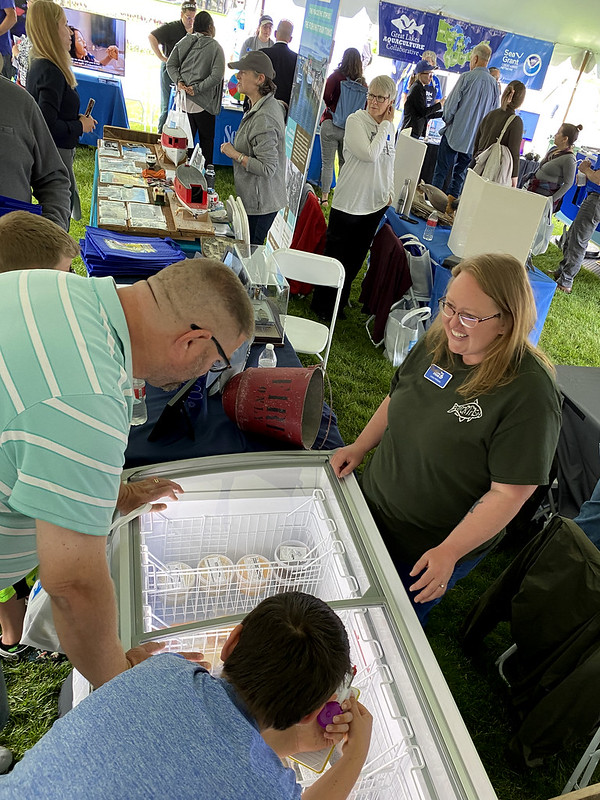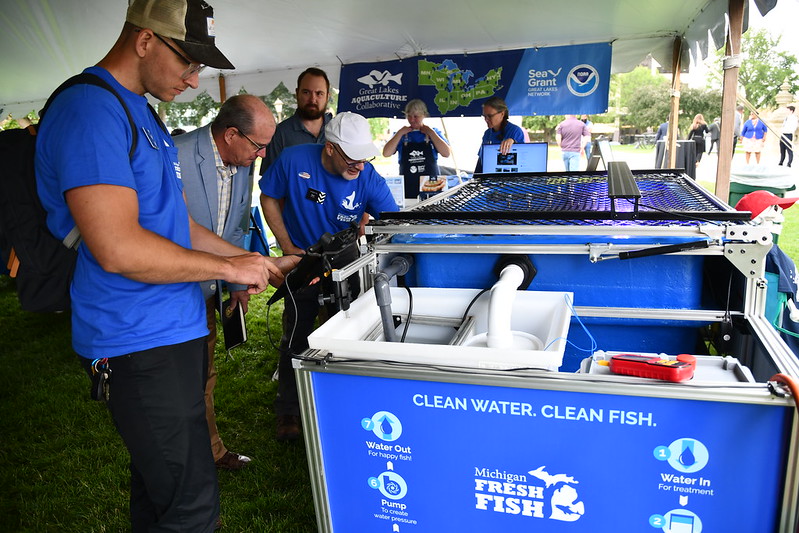First-ever Mi Fresh Fish Expo makes a splash on Michigan’s Capitol lawn
More than 500 Michiganders spent day celebrating, learning about state’s aquaculture and commercial fishing industries.

On June 13, 2023, Michiganders spent a day celebrating and learning about Michigan’s commercial fishing and aquaculture industries in front of the state capitol in Lansing. The Expo was hosted by the Michigan Fish Producers Association and Michigan Aquaculture Association, with coordination and organizational support from Michigan Sea Grant and Monte Consulting through the Mi Fresh Fish marketing campaign..
The event was an opportunity to meet with commercial fishermen and aquaculture farmers to showcase their products grown and harvested in Michigan waters. Attendees discovered where Michigan fish come from, how they are cared for and harvested, and why they’re an important part of the local economy. The industries’ messaging was a key goal of the Expo:

Producers want Michiganders to meet them and understand they are focused on food security and helping to feed Michigan. Also that they are hardworking families celebrating Michigan’s fishing culture and traditions while they continue to support their families and their legacies. Producers hoped the Expo would help create advocates for Michigan fish among Michiganders as they shared their stories.
See, eat, learn
More than 500 participants engaged with 18 vendors, 24 businesses, nine producers, sampled any of three Mi Fresh Fish species from cooking demonstrations, interacted with two interactive demos, and took a picture at the “Shore Tasty” photobooth – the Mi Fresh Fish commercial fishing trap net boat. The interactive demos included an aquaculture live tank holding live trout for stocking raised at Cedarbrook Trout Farms and a 360-Virtual Reality experience that transports viewers on a virtual tour of Cedarbrook Trout Farms. The cooking demonstrations were the star of the show as the Expo was redefining what it means to be called fresh fish.

Both aquaculture and commercial fishing industries held cooking demonstrations where all of the fish were harvested and processed the day before. Michigan Fish Producers Association showcased Big Stone Bay Fishery’s lake whitefish and yellow perch prepared by The Farm Restaurant as Pan-seared blackened Great Lakes whitefish and Deep-fried yellow perch and whitefish. Michigan Aquaculture Association showcased Harrietta Hills Trout Farm’s rainbow trout prepared by SolidFuel as O’Mykiss rainbow one-cider sandwich.
After attending, 173 participants (90% of those who took the Michigan Sea Grant evaluation survey) said yes, they plan to eat more fish. Also, of 243 participants surveyed, “what is your favorite fish to eat” detailed the following results:
|
Favorite fish to eat |
Percentage of Survey Participants (n=243) |
|
Salmon |
28% |
|
Walleye |
19% |
|
Yellow Perch |
19% |
|
Lake Whitefish |
18% |
|
Other (e.g., Rainbow Trout, Lake Trout, Catfish, etc) |
16% |
The results of participants' favorite fish to eat were surprising as 90% of state-licensed commercial fishermen harvest is lake whitefish; they are not allowed to harvest (per any quota or by-catch) of salmon or walleye. Only a few licenses in Lake Huron are allowed to catch yellow perch, but remains to be an issue of contention with recreational harvests. Aquaculture, on the other hand, does raise walleye, however, these are all raised for stocking in waters for recreational fishing, not necessarily for entering the food systems to end up in grocery stores or restaurants. Michigan aquaculture does produce food fish, but this is typically in the “other category” from above such as rainbow trout, catfish, bluegill, etc. So you might ask, then where do these fish come from that we like to eat? The answer: most are imported, and even walleye and yellow perch are from the Great Lakes waters, but even they are mostly imported from Canada.
Impacts
The Expo redefined what it meant for producers to be able to talk about and educate others on who their industries are and what they do. In addition, they are shifting the conversation to not only talk about fish as a natural resource (stocking, recreational fishing, charter fishing, population management), but to also talk about fish as food (food security, local and regional economies, equitable access, diversity, healthy, sustainability, resiliency, customs and traditions). The Mi Fresh Fish Expo brought together aquaculture and commercial fishing producers in Michigan – their first collaboration – under one tent to bring awareness that they offer Michigan-made fish, or Mi Fresh Fish, for all people in Michigan and request that state residents to support them.
Mi Fresh Fish campaign continues
The Mi Fresh Fish Expo is part of a marketing campaign to highlight the small and mighty industries bringing fish to the people of Michigan. The campaign is focused on consumer education surrounding the benefits of eating Michigan fish, the importance of buying local products to support local economies, and the high quality of standards and care in the quality of fish they produce. Mi Fresh Fish is an educational marketing campaign to bring awareness to commercial fishing and aquaculture, also known as fish farming, in Michigan. It’s about celebrating what they offer and supporting local, healthy, tasty, delicious fish.
“I’m going to be thinking about that fish all week,” remarked one participant. The Expo may be over, but the Mi Fresh Fish campaign continues encouraging consumers to choose local sources of fish for food, bait, stocking, ornamental uses, and more.
Michigan Sea Grant helps to foster economic growth and protect Michigan’s coastal, Great Lakes resources through education, research, and outreach. A collaborative effort of the University of Michigan and Michigan State University and its MSU Extension, Michigan Sea Grant is part of the NOAA-National Sea Grant network of 34 university-based programs.
Funding for the Mi Fresh Fish Campaign and Expo provided by CARES Act II, or Consolidated Appropriations Act, 2021, Pub. L. 116-260. DIVISION M - CORONAVIRUS RESPONSE AND RELIEF SUPPLEMENTAL APPROPRIATIONS ACT, 2021 TITLE I DEPARTMENT OF COMMERCE NATIONAL OCEANIC AND ATMOSPHERIC ADMINISTRATION FISHERIES DISASTER ASSISTANCE (Page 729).
This article was prepared by Michigan Sea Grant under award NA180AR4170102 from the National Oceanic and Atmospheric Administration, U.S. Department of Commerce through the Regents of the University of Michigan. The statement, findings, conclusions, and recommendations are those of the author(s) and do not necessarily reflect the views of the National Oceanic and Atmospheric Administration, the Department of Commerce, or the Regents of the University of Michigan.



 Print
Print Email
Email

